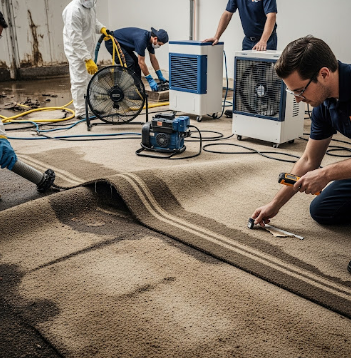Flood damage doesn’t end when the water disappears. For homeowners and property managers, the real work begins after the immediate crisis—when the structure is compromised, the air is saturated, and microbial risks are quietly multiplying. At Comfort Carpet Clean, our approach to water damage restoration prioritizes precision, safety, and sanitation—not speed at the expense of quality.
This article offers a realistic, step-by-step breakdown of what effective post-flood recovery looks like, particularly in situations involving carpeted surfaces and enclosed interiors. We clarify how clean water differs from sewage contamination, and why a structured, multi-day recovery timeline is not only practical—but essential.
Table of Contents
- Understanding the Real Risk After Flooding
- Why Rapid Action Still Requires Deliberate Strategy
- Step-by-Step: Our Proven Water Damage Protocol
- Clean Water vs. Sewer Water: Two Very Different Scenarios
- Why Timelines Vary—and What Homeowners Should Expect
- Final Sanitation: Why One Cleaning Isn’t Enough
- FAQs
Understanding the Real Risk After Flooding
When water floods a space—whether due to pipe bursts, appliance failure, or outdoor intrusion—it begins a rapid breakdown of surface, subfloor, and air quality integrity. Carpets become saturated sponges. Walls wick moisture from below. And the humidity spike can initiate microbial activity within hours.
The danger isn’t always visible. Left untreated or incompletely dried, the hidden threat of mold, bacterial spread, and structural degradation continues long after the water is gone.
Why Rapid Action Still Requires Deliberate Strategy
There’s a common misconception that the goal is to “get back to normal” within a day or two. The truth? Quality flooded basement and water restoration takes time—and rushing it risks missing deeply embedded moisture or skipping essential remediation steps.
That’s why our crews act fast to stabilize the environment—but move deliberately through a process designed to fully neutralize microbial risk, restore indoor air safety, and protect long-term flooring integrity.
Step-by-Step: Our Proven Water Damage Protocol
We follow a four-stage system for water damage restoration:
- Water Extraction
Using high-powered extraction systems, we remove standing water from carpets, padding, and flooring. This initial phase is crucial for reducing moisture load quickly and preventing further spread.
- Microbial Spray Application
Once surfaces are no longer submerged, we apply a broad-spectrum antimicrobial treatment designed to halt bacterial and fungal growth. This is especially critical for porous materials like carpet and underlay.
- Air Movers and Dehumidification
We install professional-grade air movers and dehumidifiers to remove remaining moisture from the air and underlying materials. This phase typically runs for 2–3 days, depending on severity and space size.
- Final Re-Clean and Sanitation
Once fully dry, we return to clean and sanitize the entire affected area—including carpet and floor surfaces. This ensures any lingering contaminants, odors, or residue are neutralized, and the space is safe for occupancy.
No shortcuts. No skipped steps. Just proven methodology based on field-tested outcomes.
Clean Water vs. Sewer Water: Two Very Different Scenarios
Floods aren’t all the same—and neither are the restoration requirements.
Clean Water Events
Caused by broken pipes, appliance overflows, or rainwater. While urgency is still critical, these events pose lower biohazard risk. Carpets and furnishings may often be salvaged if drying and treatment are performed promptly.
Sewer or Grey Water Events
These include toilet backups, storm drain overflows, or sump pump failures. In such cases, water is considered contaminated, and strict disinfection protocols must follow. Often, carpets, padding, and some porous materials must be discarded for health and safety reasons.
We assess and classify the water source immediately upon arrival, so no guesswork delays necessary action.
Why Timelines Vary—And What Homeowners Should Expect
It’s not realistic—or responsible—to promise a fully restored property
The timeline depends on:
- Water depth and source
- How long the water remained before extraction
- Construction type (slab vs. basement vs. crawlspace)
- Outdoor humidity and temperature
- Flooring and wall materials involved
On average, our water damage restoration process takes 3–4 days, with some high-impact cases requiring up to 5+ days for full drying and re-cleaning.
The goal is not speed. The goal is safety and long-term durability.
Final Sanitation: Why One Cleaning Isn’t Enough
Even after water is removed and surfaces feel dry, the real contaminants—microbes, odors, and residual soil—often remain. That’s why we always return for a final re-clean, focused on both sanitation and indoor air refresh.
Especially in flooded basement cases, where mustiness and mold spores can linger long after drying, this final clean-out is what distinguishes a true recovery from a temporary fix.
We leave nothing behind—not even the memory of moisture.
FAQs
Can carpet always be saved after flooding?
If the water is clean and we extract it promptly, yes. With sewer water, replacement is usually required for health reasons.
How long do air movers and dehumidifiers need to run?
Typically 48–72 hours, depending on room size, material saturation, and airflow.
Do I need to move out during the process?
Not usually. But if contamination is high or multiple rooms are affected, temporary relocation may be recommended.
Can I keep using the carpet after extraction?
Not immediately. It must be fully dry, re-sanitized, and re-cleaned before safe use—especially in homes with children or pets.
Rewind: A Strategic Response for a Safer Home
When water damage strikes, the goal isn’t just to “clean up”—it’s to correct, sanitize, and stabilize. At Comfort Carpet Clean, our process reflects a commitment to deliberate action, industry-best practices, and transparency about what it takes to recover the right way.
Because when the water recedes, the risk doesn’t end. But neither does our responsibility.

